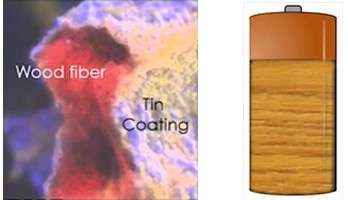Rechargeable Wooden Battery
on

Inspired by trees scientists at the University of Maryland have developed a nanobattery that uses tin-coated wood fibers to store liquid electrolytes. Replacing the lithium found in many rechargeable batteries by sodium makes the battery environmentally benign. Sodium doesn’t store energy as efficiently as lithium, so you won’t see this battery in your cell phone - instead, its low cost and common materials would make it ideal to store huge amounts of energy at once, such as solar energy at a power plant.
Existing batteries are often created on stiff bases, which are too brittle to withstand the swelling and shrinking that happens as electrons are stored in and used up from the battery. The researchers found that wood fibers are supple enough to let their sodium-ion battery with an initial capacity of 339 mAh/g last more than 400 charging cycles. This puts it among the longest lasting nanobatteries.
The researchers noticed that after charging and discharging the battery hundreds of times, the wood ended up wrinkled but intact. Pushing sodium ions through tin anodes often weaken the tin’s connection to its base material, but the wood fibers are soft enough to serve as a mechanical buffer, and thus can accommodate tin’s changes. This is the key to our long-lasting sodium-ion batteries.



Discussion (0 comments)